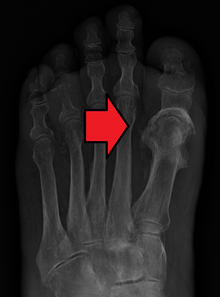Signs and Symptoms
- Pain in a specific bone with overlying redness
- Fever
- Weakness
- Inability to walk, especially in children with acute bacterial osteomyelitis
- Enlarged lymph nodes may be present
Causes and Risk Factors
- Bacterial infection
- Fungal infection
- Trauma or injury to the bone
- Surgical procedures
- Bloodstream infection
- Diabetes
- Compromised immune system
- Intravenous drug use
- Chronic skin ulcers
- Recent surgery or trauma
Pathogenesis and Diagnosis
- Infection can occur via the bloodstream, nearby areas of infection, or penetrating trauma
- The metaphysis of the bone is usually affected when infection is contracted through the bloodstream
- Leukocytes enter the infected area and release enzymes that lyse the bone
- Pus spreads into the bone's blood vessels, impairing their flow
- Chronic osteomyelitis can lead to bone sclerosis and deformity
- Diagnosis is suspected based on symptoms and basic laboratory tests
- C-reactive protein (CRP) and erythrocyte sedimentation rate (ESR) are commonly used tests
- Plain radiographs are usually unremarkable in the first few days following acute infection
- Blood tests, medical imaging, or bone biopsy can confirm the diagnosis
- Diagnosis may also involve assessing risk factors such as diabetes or prior spleen removal
Treatment Options
- Bacterial osteomyelitis often requires antimicrobials and surgery
- In people with poor blood flow, amputation may be necessary
- Fungal osteomyelitis requires antifungal medications
- Neglected fungal osteomyelitis may require amputation or large bony resections
- Treatment outcomes of bacterial osteomyelitis are generally good when caught early, with a low mortality rate
- Prolonged antibiotic therapy
- Surgical debridement in severe cases
- Use of PICC line or central venous catheter for intravenous medication
- Regional differences in common infective organisms determine initial antibiotic choice
- Hyperbaric oxygen therapy as an adjunct treatment
Complications and Other Information
- Chronic infection that is difficult to treat
- Bone deformities or limb length discrepancies
- Spread of infection to surrounding tissues or joints
- Septicemia or bloodstream infection
- Development of abscesses or pus-filled pockets
- Greek origins of the word osteomyelitis
- Thomas Eakins' depiction of a surgical procedure for osteomyelitis
- Canadian politician Tommy Douglas' experience with osteomyelitis
- Douglas' surgeries performed for free in exchange for medical student observation
- Douglas' impact on healthcare in Canada
- Osteomyelitis studied by paleopathologists
- Evidence of osteomyelitis in fossils of Allosaurus fragilis
- Association of osteomyelitis with the first evidence of parasites in dinosaur bones
Osteomyelitis (OM) is an infection of bone. Symptoms may include pain in a specific bone with overlying redness, fever, and weakness. The long bones of the arms and legs are most commonly involved in children e.g. the femur and humerus, while the feet, spine, and hips are most commonly involved in adults.
| Osteomyelitis | |
|---|---|
| Other names | Bone infection |
 | |
| Osteomyelitis of the 1st toe | |
| Specialty | Infectious disease, orthopedics |
| Symptoms | Pain in a specific bone, overlying redness, fever, weakness |
| Complications | Amputation |
| Usual onset | Young or old |
| Duration | Short or long term |
| Causes | Bacterial, fungal |
| Risk factors | Diabetes, intravenous drug use, prior removal of the spleen, trauma to the area |
| Diagnostic method | Blood tests, medical imaging, bone biopsy |
| Differential diagnosis | Charcot's joint, rheumatoid arthritis, infectious arthritis, giant cell tumor, cellulitis |
| Treatment | Antimicrobials, surgery |
| Prognosis | Low risk of death with treatment |
| Frequency | 2.4 per 100,000 per year |
The cause is usually a bacterial infection, but rarely can be a fungal infection. It may occur by spread from the blood or from surrounding tissue. Risks for developing osteomyelitis include diabetes, intravenous drug use, prior removal of the spleen, and trauma to the area. Diagnosis is typically suspected based on symptoms and basic laboratory tests as C-reactive protein (CRP) and erythrocyte sedimentation rate (ESR). This is because plain radiographs are unremarkable in the first few days following acute infection. Diagnosis is further confirmed by blood tests, medical imaging, or bone biopsy.
Treatment of bacterial osteomyelitis often involves both antimicrobials and surgery. In people with poor blood flow, amputation may be required. Treatment of the relatively rare fungal osteomyelitis as mycetoma infections entails the use of antifungal medications. In contrast to bacterial osteomyelitis, amputation or large bony resections is more common in neglected fungal osteomyelitis, namely mycetoma, where infections of the foot account for the majority of cases. Treatment outcomes of bacterial osteomyelitis are generally good when the condition has only been present a short time. About 2.4 per 100,000 people are affected each year. The young and old are more commonly affected. Males are more commonly affected than females. The condition was described at least as early as the 300s BC by Hippocrates. Prior to the availability of antibiotics, the risk of death was significant.
osteo- + myelitis
osteomyelitis (usually uncountable, plural osteomyelitides or osteomyelites or osteomyelitises)